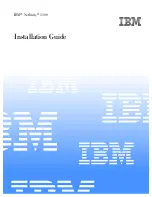
15.
Connect
the
power
cable
to
the
back
of
the
drive.
The
connectors
are
keyed
and
can
be
inserted
only
one
way.
If
you
have
other
devices
to
install
or
remove,
do
so
now.
Otherwise,
go
to
“Completing
the
installation”
on
page
34.
Power
and
signal
cables
for
internal
drives
The
server
uses
cables
to
connect
parallel
IDE,
Serial
ATA,
and
SCSI
devices
(such
as
tape
drives)
to
the
power
supply
and
to
the
system
board.
(See
“System-board
internal
connectors”
on
page
14
for
the
location
of
connectors.)
Review
the
following
information
before
you
connect
power
and
signal
cables
to
internal
drives:
v
The
drives
that
are
preinstalled
in
the
server
come
with
attached
power
and
signal
cables.
If
you
replace
any
drives,
remember
which
cable
is
attached
to
which
drive.
v
When
you
install
a
drive,
make
sure
that
one
of
the
signal
cable
drive
connectors
is
connected
to
the
drive
and
that
the
connector
at
the
other
end
of
the
signal
cable
is
connected
to
the
system
board.
v
If
one
IDE
device
is
connected
to
a
cable,
it
must
be
set
as
a
master
device.
v
If
two
IDE
devices
are
used
on
a
single
cable,
one
must
be
designated
as
the
master
device
and
the
other
as
the
subordinate
device;
otherwise,
the
server
might
not
recognize
some
of
the
IDE
devices.
The
master
and
subordinate
designation
is
determined
by
switch
or
jumper
settings
on
each
IDE
device.
The
following
cables
are
provided:
v
Power
cables:
Four-wire
power
cables
connect
the
drives
to
the
power
supply.
At
the
end
of
these
cables
are
plastic
connectors
that
can
be
attached
to
different
drives;
these
connectors
vary
in
size.
Use
either
a
four-wire
power
cable
or
Serial
ATA
power
cable
with
Serial
ATA
drives,
but
do
not
use
both
at
the
same
time
(use
one
or
the
other).
v
Signal
cables:
Signal
cables
are
typically
flat
cables,
also
called
ribbon
cables,
that
connect
parallel
IDE,
Serial
ATA,
SCSI,
and
diskette
drives
to
the
system
board.
Two
or
three
types
of
signal
cables
come
with
the
server:
–
IDE:
The
wider
IDE
signal
cable
has
three
connectors.
One
of
these
connectors
is
attached
to
the
drive,
one
is
a
spare,
and
the
third
is
attached
to
the
primary
or
secondary
IDE
connector
on
the
system
board.
The
spare
connector
can
be
used
to
connect
an
additional
IDE
drive
to
the
server.
The
CD
or
DVD
drive
is
attached
to
an
ATA
100
signal
cable.
ATA
100
signal
cables
are
color-coded.
The
blue
connector
is
attached
to
the
system
board.
The
black
connector
is
attached
to
the
master
IDE
device.
The
gray
middle
connector
is
attached
to
the
subordinate
IDE
device.
–
(Optional)
Diskette
drive:
The
narrower
signal
cable
has
two
connectors.
One
is
attached
to
the
diskette
drive,
and
the
other
is
connected
to
the
connector
(FDD1)
on
the
system
board.
–
Serial
ATA
(SATA):
The
narrower,
black
signal
cable
has
two
connectors.
One
is
connected
to
the
Serial
ATA
drive,
and
the
other
is
attached
to
the
connector
on
the
system
board.
Each
Serial
ATA
drive
comes
with
a
cable.
If
you
install
an
additional
Serial
ATA
drive,
you
will
need
an
additional
cable.
If
you
install
an
optional
ServeRAID-7t
S-ATA
controller,
all
SATA
drives
must
then
be
connected
to
the
ServeRAID-7t
S-ATA
controller
instead
of
the
system
board.
The
controller
comes
with
two
cables.
See
the
ServeRAID-7t
S-ATA
controller
documentation
for
cabling
instructions.
Chapter
2.
Installing
optional
devices
31
Summary of Contents for System x3105 Type 4347
Page 1: ...System x3105 Type 4347 User s Guide...
Page 2: ......
Page 3: ...System x3105 Type 4347 User s Guide...
Page 66: ...54 System x3105 Type 4347 User s Guide...
Page 70: ...58 System x3105 Type 4347 User s Guide...
Page 71: ......
Page 72: ...Part Number 43W7036 Printed in USA 1P P N 43W7036...
















































